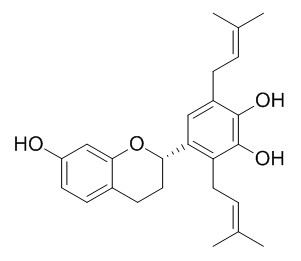Kazinol A
Kazinol A shows strong inhibition of arachidonic acid (AA)-induced platelet aggregation. It also exhibits potent inhibition with IC50 values ranging 0.6–164 M against XOD. Kazinol A may be a candidate for the development of effective anti-cancer drug on human urinary bladder cancer, it induces cytotoxic effects in human bladder cancer cells, including the cisplatin-resistant T24R2.
Inquire / Order:
manager@chemfaces.com
Technical Inquiries:
service@chemfaces.com
Tel:
+86-27-84237783
Fax:
+86-27-84254680
Address:
1 Building, No. 83, CheCheng Rd., Wuhan Economic and Technological Development Zone, Wuhan, Hubei 430056, PRC
Providing storage is as stated on the product vial and the vial is kept tightly sealed, the product can be stored for up to
24 months(2-8C).
Wherever possible, you should prepare and use solutions on the same day. However, if you need to make up stock solutions in advance, we recommend that you store the solution as aliquots in tightly sealed vials at -20C. Generally, these will be useable for up to two weeks. Before use, and prior to opening the vial we recommend that you allow your product to equilibrate to room temperature for at least 1 hour.
Need more advice on solubility, usage and handling? Please email to: service@chemfaces.com
The packaging of the product may have turned upside down during transportation, resulting in the natural compounds adhering to the neck or cap of the vial. take the vial out of its packaging and gently shake to let the compounds fall to the bottom of the vial. for liquid products, centrifuge at 200-500 RPM to gather the liquid at the bottom of the vial. try to avoid loss or contamination during handling.
J Biomol Struct Dyn.2024, 1-12.
Antioxidants.2022, 11(4), 67.
Nutr Cancer.2024, 76(3):305-315.
Journal of Cluster Science2024, 35:635-656.
Agronomy2023, 13(6), 1435.
Molecules.2023, 28(10):4062.
Food Structure2023, 36:100324.
Chemistry of Natural Compounds2018, 204-206
Phytomedicine.2024, 128:155527.
ACS Nano.2023, 17(11):9972-9986.
Related and Featured Products
Phytomedicine, 2016, 23(12):1462-1468.
Cytotoxic effects of kazinol A derived from Broussonetia papyrifera on human bladder cancer cells, T24 and T24R2.[Reference:
WebLink]
Broussonetia papyrifera (B. papyrifera), also known as paper mulberry, has been used as a traditional medicine for the treatment of several diseases, including ophthalmic disorders and impotency. However, the biological activity of Kazinol A (1) among flavonols isolated from B. papyrifera has not been identified.
We identified a candidate metabolite for anti-human bladder cancer treatment from B. papyrifera and investigated the possible molecular mechanisms underlying its cytotoxic effects in T24 and cisplatin-resistant T24R2 human bladder cancer cells.
METHODS AND RESULTS:
T24 and T24R2 cells were treated with five flavonols from B. papyrifera and their cytotoxic effects were determined using MTT assay, cell cycle analysis, mitochondrial membrane potential, and propidium iodide staining. Autophagy rate was calculated by counting LC3-GFP dots in the cells. All related protein expressions were analyzed by immunoblotting.
Compound 1 showed relatively higher cytotoxicity in the human bladder cancer cells, T24 and T24R2, rather than other tissues-originated cancer cells. Compound 1 significantly attenuated cell growth through G0/1 arrest mediated by a decrease in cyclin D1 and an increase of p21. Apoptosis and autophagy induced by compound 1 treatment was accompanied by a modulation of the AKT-BAD pathway and AMPK-mTOR pathway, respectively.
CONCLUSIONS:
Our results suggest that compound 1 induces cytotoxic effects in human bladder cancer cells, including the cisplatin-resistant T24R2. Compound 1 may be a candidate for the development of effective anti-cancer drug on human urinary bladder cancer.
Journal of Natural Products, 1996, 59(9):834-838.
Novel Antiplatelet Constituents from Formosan Moraceous Plants.[Reference:
WebLink]
Sixteen constituents from Formosan Moraceous plants were tested for their antiplatelet activities in rabbit platelet suspension and human platelet-rich plasma.
METHODS AND RESULTS:
Cycloartocarpin A, cycloheterophyllin, broussochalcone A, Kazinol A, broussoaurone A, and broussoflavonol F showed strong inhibition of arachidonic acid (AA)-induced platelet aggregation. Of the compounds tested, broussochalcone A exhibited the most potent inhibition of platelet aggregation induced by AA (IC50 = 6.8 microM).
CONCLUSIONS:
The antiplatelet effects of cycloheterophyllin, broussochalcone A, kazinol B, broussoaurone A, and broussoflavonol F are partially due to an inhibitory effect on cyclooxygenase.
Journal of the Korean Society for Applied Biological Chemistry, 2012, 55(5):587-594.
Inhibition of Xanthine Oxidase by Phenolic Phytochemicals from Broussonetia papyrifera.[Reference:
WebLink]
The roots of Broussonetia papyrifera were extracted into four different polar solvents: chloroform, 50% ethanol in water, ethanol, and water.
METHODS AND RESULTS:
The ethanol extract showed the most potent inhibition (72.3% at 20 g/mL) against xanthine oxidase (XOD). Chromatography of EE yielded nine phenolic phytochemicals, which were confirmed as broussochalcone A (1), broussochalcone B (2), 3,4-dihydroxyisolonchocarpin (3), 4-hydroxyisolonchocarpin (4), 3-′(3-methylbut-2-enyl)-3′,4′,7-trihydroxyflavane (5), Kazinol A (6), kazinol B (7), kazinol E (8), and broussoflavan A (9). All isolated compounds (19) possessed potent antioxidant activities against 2,2-diphenyl-l-picrylhydrazyl and 2,2′-azino-bis-ethylbenzthiazoline-6-sulfonic acid (ABTS) radicals with IC50 values ranging from 5.8 to 252.8M.
CONCLUSIONS:
Although most compounds exhibited potent inhibition with IC50 values ranging 0.6–164 M against XOD, compounds 1 and 3 were found to be the principal contributors to the XOD inhibition in ethanol extract. The analysis of K I and K IS values proved that the two most promising compounds (1 and 3), present at high concentrations in the root barks as analyzed by using high-performance liquid chromatography analysis, were reversible mixed type I inhibitors.



